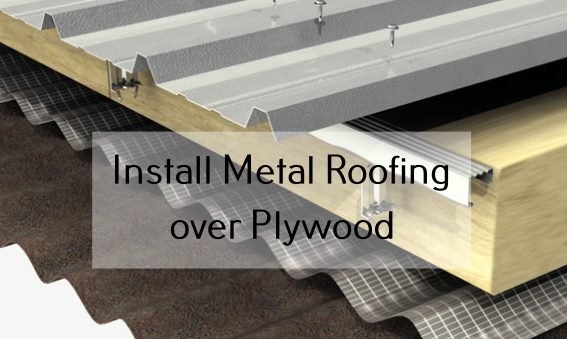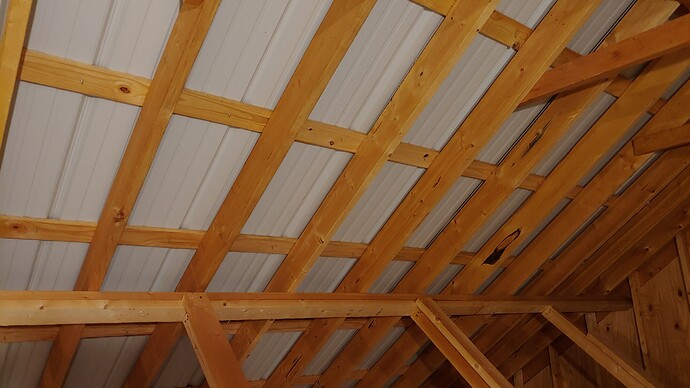When it comes to setting up a shed with a metal roof, one question that often comes up is, “Do you need plywood under a metal roof on a shed?” It’s a valid concern since the roof is a crucial component of any structure. In this article, we’ll dive into this topic and provide you with the information you need to make an informed decision.
Whether you’re a budding DIY enthusiast or simply curious about shed construction, this article will break down the pros and cons of using plywood as an underlayment for a metal roof on a shed. By the end, you’ll have a clear understanding of whether or not plywood is necessary and why.
So, let’s get started and find out if installing plywood under a metal roof on your shed is a step you should consider taking!

Do You Need Plywood Under a Metal Roof on a Shed? The Ultimate Guide
Metal roofs are a popular choice for sheds due to their durability and longevity. However, many shed owners wonder if it is necessary to have plywood under a metal roof. In this comprehensive guide, we will explore the benefits of using plywood under a metal roof, the considerations to keep in mind, and some essential tips for installation. Whether you are a DIY enthusiast or a seasoned shed owner, this guide will provide you with all the information you need to make an informed decision.
Benefits of Using Plywood Under a Metal Roof on a Shed
Using plywood under a metal roof on a shed offers several advantages.
1. Structural Integrity and Support
Plywood provides additional structural integrity to your shed. It acts as a solid base for the metal roof, distributing the weight evenly and preventing it from sagging or buckling. The plywood also helps to support the metal panels and prevent any potential damage from wind uplift or heavy snow loads. By adding plywood, you can ensure that your shed’s roof remains stable and secure throughout its lifespan.
2. Noise Reduction
Metal roofs can be noisy, especially during rain or hailstorms. However, using plywood as an underlayment can significantly reduce the noise levels. The plywood acts as a sound barrier, absorbing and dampening the impact of raindrops on the metal roof. This can make your shed a more pleasant and peaceful space, whether you are using it for storage or as a workshop.
3. Enhanced Insulation
Plywood can provide some level of insulation to your shed, helping to regulate the temperature inside. This is especially important if you are using your shed as a workspace or for storing temperature-sensitive items. The plywood acts as an additional layer of insulation, reducing heat transfer from the metal roof and minimizing heat buildup in the summer. It can also help to retain warmth in the winter, creating a more comfortable environment overall.
Considerations When Using Plywood Under a Metal Roof on a Shed
While there are many benefits to using plywood under a metal roof on a shed, there are also some considerations to keep in mind.
1. Moisture Protection
Moisture is a common concern when it comes to sheds, and plywood can help mitigate this issue. However, it is essential to take steps to protect the plywood itself from moisture damage. Using a waterproof barrier between the plywood and the metal roof can prevent water infiltration. Additionally, proper ventilation is crucial to ensure that any trapped moisture can escape, preventing rot, mold, and mildew growth.
2. Weight Considerations
Adding plywood under a metal roof will increase the overall weight of the shed. It is important to ensure that the shed’s structure can handle the additional load. Consult the shed’s manufacturer or a structural engineer to determine the maximum weight capacity and ensure that the plywood and metal roof do not exceed it. Reinforcements may be necessary to support the added weight, especially if you live in an area prone to heavy snow or strong winds.
3. Cost and Maintenance
Using plywood under a metal roof will add to the cost of your shed construction or renovation project. However, the long-term benefits may outweigh the initial investment. Additionally, keep in mind that plywood may require regular maintenance, such as sealing or painting, to protect it from the elements and extend its lifespan. Consider these factors when deciding whether or not to use plywood under your shed’s metal roof.
Tips for Installing Plywood Under a Metal Roof on a Shed
If you decide to use plywood under a metal roof on your shed, here are some essential tips to ensure a successful installation:
1. Choose the Right Plywood
Select plywood specifically designed for exterior use, as it will be exposed to the elements. Look for pressure-treated or marine-grade plywood that is resistant to moisture and rot. Ensure that the plywood meets the necessary structural requirements for your shed.
2. Properly Prepare the Surface
Before installing the plywood, ensure that the shed’s roof surface is clean and free of any debris or protruding nails. Secure any loose or damaged sections of the existing roof. Apply a waterproof barrier over the entire surface to protect the plywood from moisture.
3. Use the Correct Fasteners
Choose the appropriate fasteners, such as roofing screws or nails, to secure the plywood to the roof trusses or sheathing. Ensure that the fasteners are long enough to penetrate both the plywood and the underlying structure securely. Follow the manufacturer’s recommendations for spacing and placement.
4. Install Ventilation
Proper ventilation is crucial when using plywood under a metal roof to prevent moisture buildup. Install soffit vents, ridge vents, or other ventilation systems to allow for air circulation and moisture escape. This will help prolong the lifespan of both the plywood and the metal roof.
5. Regularly Inspect and Maintain
Periodically inspect the plywood and metal roof for signs of damage, wear, or water intrusion. Replace any damaged or deteriorated sections promptly to prevent further issues. Regularly clean and maintain the metal roof to ensure its longevity and performance.
Remember, the decision of whether or not to use plywood under a metal roof on your shed ultimately depends on your specific needs and circumstances. Consider the benefits, considerations, and installation tips provided in this guide to make an informed choice. By taking the time to properly install and maintain your shed’s roof, you can ensure its durability and functionality for years to come.
Key Takeaways: Do You Need Plywood Under a Metal Roof on a Shed?
- Plywood is not always necessary under a metal roof on a shed, but it can provide added structural support.
- If your shed has wide roof spans or if you plan to install heavy equipment on the roof, using plywood is recommended.
- Plywood can also help to prevent noise from rain or hail hitting the metal roof.
- Adding plywood underneath a metal roof can enhance insulation and energy efficiency.
- Consult local building codes and regulations to determine if plywood is required in your area.
Frequently Asked Questions
Are you considering installing a metal roof on your shed? Here are some commonly asked questions about whether you need plywood under a metal roof on a shed, along with their answers:
1. What is the purpose of plywood under a metal roof on a shed?
Plywood serves as a solid base for the metal roofing. It helps distribute the weight of the roof evenly, preventing sagging or warping. Plywood also adds structural stability and provides a smooth surface for installing the metal panels.
The plywood acts as a barrier between the metal roof and the shed’s framing, preventing moisture from seeping into the structure. It also adds an additional layer of insulation, helping to regulate the shed’s temperature.
2. Can I skip using plywood and install the metal roof directly on the shed’s framing?
While it may be tempting to skip the step of using plywood, it is generally not recommended. Plywood provides a protective layer that helps prevent water infiltration and adds structural support. Without plywood, the metal panels may not have a secure base, leading to potential issues such as leaks and damage to the shed’s framework.
Using plywood also allows for easier installation of the metal roof. It provides a solid surface for screwing or nailing the metal panels, ensuring a secure and professional-looking installation.
3. What type and thickness of plywood should I use?
For a shed roof, it is recommended to use 1/2 inch or 5/8 inch thick exterior-grade plywood. This type of plywood is designed to withstand moisture and temperature changes. Additionally, ensure that the plywood is rated for structural use to provide adequate support for the metal roof.
Consider the local climate conditions when selecting the type of plywood. If you live in an area with high humidity or frequent rain, choose water-resistant plywood. Consulting with a local building professional can help you determine the best plywood for your specific shed and climate.
4. Are there any situations where plywood may not be necessary under a metal roof on a shed?
While plywood is generally recommended, there may be some situations where it may not be necessary. If your shed has a solid, well-built and reinforced roof deck, it may already provide the required support for the metal roof. However, it is still advisable to consult with a roofing professional to ensure the structural integrity and proper installation of the metal roof.
Additionally, if you are installing a metal roof over an existing roof with a solid substrate, such as a layer of asphalt shingles, the plywood may not be necessary. In such cases, the existing roof can serve as a suitable base for the metal panels.
5. Can I save money by using lower-quality plywood under a metal roof on a shed?
While it may be tempting to cut costs by using lower-quality plywood, it is not recommended. Using subpar plywood may compromise the structural integrity of your shed. Lower-quality plywood may be more prone to warping, rotting, and deteriorating over time, leading to potential issues with your metal roof.
Investing in high-quality exterior-grade plywood ensures that your shed and metal roof remain durable and long-lasting. It is worth the investment to use plywood that is specifically designed for structural support and able to withstand the elements.

Summary
If you’re wondering whether you need plywood under a metal roof on a shed, here’s what you need to know. Plywood under a metal roof can help with insulation and prevent condensation. However, it’s not always necessary, especially for small sheds with a solid roof frame. Make sure to check local building codes and guidelines before deciding. If you choose not to use plywood, you can use foam insulation instead to prevent condensation. Remember, safety should always be your priority, so consult with an expert if you’re unsure.
